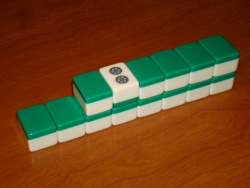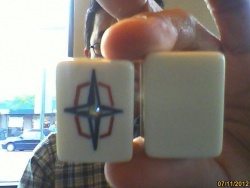Dora

Dora (ドラ) is a feature to the game, where possession of specific tiles instantly grants the hand 1 han per tile. Regardless, hands must still possess a yaku in order to score, regardless of the number of dora in the hand. At the start of every hand, 14 tiles are set aside as the wanpai, or dead wall tiles.
Dead wall
Wanpai 「王牌」 are the tiles used to form the dead wall. These tiles are set aside from the regular draw and discard play. These are generally inaccessible, unless players call kan. At all time, the dead wall must be maintained at 14 tiles. In the event of a kan call, a tile is drawn by the player, and so a replacement tile from the end of the regular wall is added to the end of the dead wall.
Every mahjong hand session has 14 tiles set aside from the regular tile draw and discard processes. These tiles are considered to be out of play, hence the nomenclature "dead wall". Among the dead wall, one tile is flipped and revealed for everyone. This tile is assigned as the dorahyouji 「ドラ表示」, or "dora indicator". Tiles marked as dora are indicated as the next tile in the sequence.
For example, if the dora indicator shows ![]() , then the dora tile is
, then the dora tile is ![]() .
.
Dora order
This lists the complete dora order. As a repeat, the dora is the next tile within each of the following orders. Dora are not "cross indicated" among the different suits. Furthermore, the dora order loops.
Suit order
Wind order
Dragon order
Duplicated dora
In the event a dora indicator is repeated, either as a kandora or uradora, then the dora tile is worth the number of han as the dora indicator shows.
Example:
- Dora indicators
Other types of dora
Additional indicators of dora may be found in the game.
Akadora
Akadora are specifically marked red tiles. If included in the game, these "red fives" automatically count as dora, regardless of the dora indicator. If the dora indicator is a four, the red five of the same suit counts as two dora.
Red haku

Though rarely found, some older sets include a "red haku" tile (white dragon).
Uradora
This applies only to hands won using riichi. In the event a riichi declared hand has won, the tiles underneath the dora indicator(s) are revealed. These newly revealed tiles serve as additional dora indicators. Potentially, such hands may potentially gain substantial value, just off of the ura dora.
If there are multiple identical indicators, each indicated tile counts as multiple dora correspondingly.
Kandora
After a call for kan, additional dora indicators are flipped. These are tiles next to the dora indicator counter clockwise on the dead wall. Depending on the rules and/or formality of the game, the timing for flipping the kandora during a kan procedure may vary. Casual games will simply flip the kan dora immediately after kan. More technical games will differentiate between the kan types, where the kan dora may be flipped after the player makes a discard.
Likewise, in the event of riichi, the uradora underneath the kandora are also revealed, as kanuradora.
External links
- Dora in Japanese Wikipedia